
A high-voltage direct current (HVDC) electric power transmission system uses direct current (DC) for electric power transmission, in contrast with the more common alternating current (AC) transmission systems.
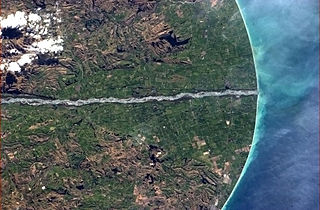
The Waitaki River is a large braided river on the South Island of New Zealand. It drains the Mackenzie Basin and runs 209 kilometres (130 mi) south-east to enter the Pacific Ocean between Timaru and Oamaru on the east coast. It starts at the confluence of the Ōhau and Tekapo rivers, now at the head of the artificial Lake Benmore, these rivers being fed by three large glacial lakes, Pukaki, Tekapo, and Ōhau at the base of the Southern Alps. The Waitaki flows through Lake Benmore, Lake Aviemore and Lake Waitaki, these lakes being contained by hydroelectric dams, Benmore Dam, Aviemore Dam and Waitaki Dam. The Waitaki has several tributaries, notably the Ahuriri River and the Hakataramea River. It passes Kurow and Glenavy before entering the Pacific Ocean. The River lends its name the Waitaki District on the south side of the river bank.

The HVDC Cross-Channel is the 73-kilometre-long (45 mi) high-voltage direct current (HVDC) interconnector that has operated since 1986 under the English Channel between the continental European grid at Bonningues-lès-Calais and the British electricity grid at Sellindge. The cable is also known as IFA, and should not be confused with the new IFA-2, another interconnect with France that is three times as long but only half as powerful.
The HVDC Inter-Island link is a 610 km (380 mi) long, 1200 MW high-voltage direct current (HVDC) transmission system connecting the electricity networks of the North Island and South Island of New Zealand together. It is commonly referred to as the Cook Strait cable in the media and in press releases, although the link is much longer than its Cook Strait section. The link is owned and operated by state-owned transmission company Transpower New Zealand.

The Pacific DC Intertie is an electric power transmission line that transmits electricity from the Pacific Northwest to the Los Angeles area using high voltage direct current (HVDC). The line capacity is 3.1 gigawatts, which is enough to serve two to three million Los Angeles households and represents almost half of the Los Angeles Department of Water and Power (LADWP) electrical system's peak capacity.

The Nelson River DC Transmission System, also known as the Manitoba Bipole, is an electric power transmission system of three high voltage, direct current lines in Manitoba, Canada, operated by Manitoba Hydro as part of the Nelson River Hydroelectric Project. It is now recorded on the list of IEEE Milestones in electrical engineering. Several records have been broken by successive phases of the project, including the largest mercury-arc valves, the highest DC transmission voltage and the first use of water-cooled thyristor valves in HVDC.

Lake Benmore is New Zealand's largest artificial lake. Located in the South Island of New Zealand and part of the Waitaki River, it was created in the 1960s by construction of Benmore Dam.
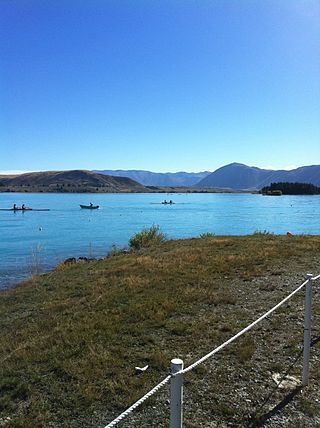
Lake Ruataniwha is an artificial lake in the Mackenzie Basin in the South Island of New Zealand. It was formed in 1977–1981 as part of the Waitaki hydroelectric project. It lies on the traditional boundary of the Canterbury and Otago provinces, with the town of Twizel two kilometres to the north.
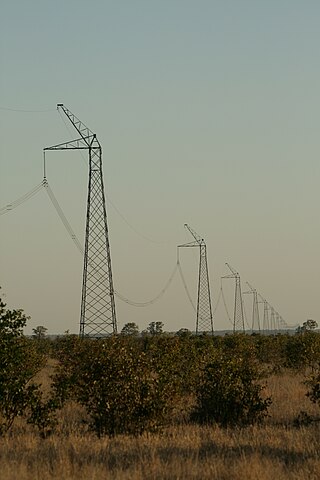
Cahora-Bassa is an HVDC power transmission system between the Cahora Bassa Hydroelectric Generation Station at the Cahora Bassa Dam in Mozambique, and Johannesburg, South Africa.

An HVDC converter station is a specialised type of substation which forms the terminal equipment for a high-voltage direct current (HVDC) transmission line. It converts direct current to alternating current or the reverse. In addition to the converter, the station usually contains:
The HVDC Itaipu is a High-voltage direct current overhead line transmission system in Brazil from the Itaipu hydroelectric power plant to the region of São Paulo. The project consists of two ±600 kV bipoles, each with a rated power of 3150 MW, which transmit power generated at 50 Hz from the Paraguay side of the Itaipu Dam to the Ibiúna converter station near São Roque, São Paulo. The system was put in service in several steps between 1984 and 1987, and remains among the most important HVDC installations in the world.
The electricity sector in New Zealand uses mainly renewable energy, such as hydropower, geothermal power and increasingly wind energy. As of 2019, 82% of electricity is generated from renewable sources, making New Zealand one of the countries with the lowest carbon dioxide emissions from electricity generation. Electricity demand grew by an average of 2.1% per year from 1974 to 2010 but decreased by 1.2% from 2010 to 2013.
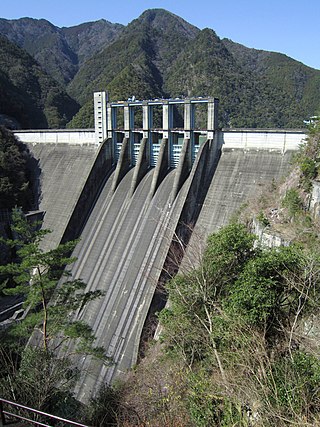
The Sakuma Dam is a dam on the Tenryū River, located on the border of Toyone, Kitashitara District, Aichi Prefecture on the island of Honshū, Japan. It is one of the tallest dams in Japan and supports a 350 MW hydroelectric power station. Nearby a frequency converter station is installed, allowing interchange of power between Japan's 50 Hz and 60 Hz AC networks.
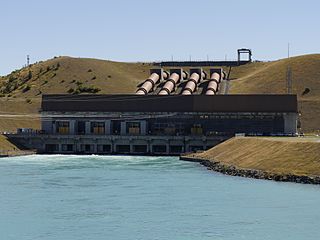
Ōhau A is a power station operated by Meridian Energy in the South Island of New Zealand.
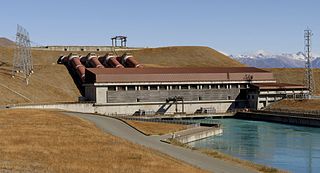
Ōhau C is a power station operated by Meridian Energy in the South Island of New Zealand.
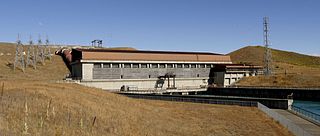
Ōhau B is a power station operated by Meridian Energy in the South Island of New Zealand.
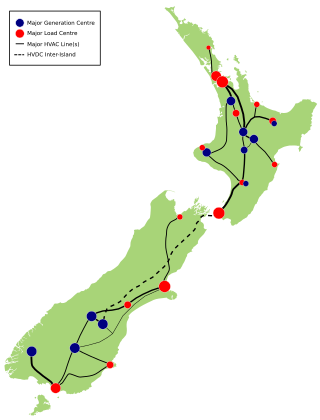
The National Grid is the nationwide system of electric power transmission in New Zealand. The grid is owned, operated and maintained by Transpower New Zealand, a state-owned enterprise, although some lines are owned by local distribution companies and leased to Transpower. In total, the national grid contains 11,803 kilometres (7,334 mi) of high-voltage lines and 178 substations.

The Alps 2 Ocean Cycle Trail is a cycle trail. This trail is one of the projects of the New Zealand Cycle Trail. The trail extends more than 300 kilometres (190 mi) from Aoraki / Mount Cook to Oamaru on the Pacific Ocean. From west to east, it descends from an altitude of 780 metres (2,560 ft) down to sea level. The trail has both on and off-road sections.
The Xiangjiaba–Shanghai HVDC system is a ±800 kV, 6400 MW high-voltage direct current transmission system in China. The system was built to export hydro power from Xiangjiaba Dam in Sichuan province, to the major city of Shanghai. Built and owned by State Grid Corporation of China (SGCC), the system became the world’s largest-capacity HVDC system when it was completed in July 2010, although it has already been overtaken by the 7200 MW Jinping–Sunan HVDC scheme which was put into operation in December 2012. It also narrowly missed becoming the world’s first 800 kV HVDC line, with the first pole of the Yunnan–Guangdong project having been put into service 6 months earlier. It was also the world’s longest HVDC line when completed, although that record is also expected to be overtaken early in 2013 with the completion of the first bipole of the Rio Madeira project in Brazil.

















